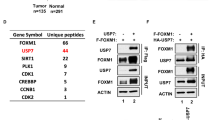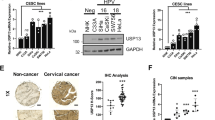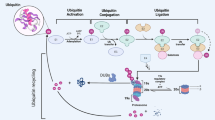Abstract
It has previously been shown that ubiquitin-specific protease 2a (USP2a) is a regulator of the Mdm2/p53 pathway. USP2a binds to Mdm2 and can deubiquitinate Mdm2 without reversing Mdm2-mediated p53 ubiquitination. Overexpression of USP2a causes accumulation of Mdm2 and promotes p53 degradation. We now show that MdmX is also a substrate for USP2a. MdmX associates with USP2a independently of Mdm2. Ectopic expression of wild-type USP2a but not a catalytic mutant prevents Mdm2-mediated degradation of MdmX. This correlates with the ability of wild-type USP2a to deubiquitinate MdmX. siRNA-mediated knockdown of USP2a in NTERA-2 testicular embryonal carcinoma cells and MCF7 breast cancer cells causes destabilization of MdmX and results in a decrease in MdmX protein levels, showing that endogenous USP2a participates in the regulation of MdmX stability. The therapeutic drug, cisplatin decreases MdmX protein expression. USP2a mRNA and protein levels were also reduced after cisplatin exposure. The magnitude and time course of USP2a downregulation suggests that the reduction in USP2a levels could contribute to the decrease in MdmX expression following treatment with cisplatin. Knockdown of USP2a increases the sensitivity of NTERA-2 cells to cisplatin, raising the possibility that suppression of USP2a in combination with cisplatin may be an approach for cancer therapy.
This is a preview of subscription content, access via your institution
Access options
Subscribe to this journal
Receive 50 print issues and online access
$259.00 per year
only $5.18 per issue
Buy this article
- Purchase on Springer Link
- Instant access to full article PDF
Prices may be subject to local taxes which are calculated during checkout





Similar content being viewed by others
References
Barboza JA, Iwakuma T, Terzian T, El-Naggar AK, Lozano G . (2008). Mdm2 and Mdm4 loss regulates distinct p53 activities. Mol Cancer Res 6: 947–954.
Bottger V, Bottger A, Garcia-Echeverria C, Ramos YF, van der Eb AJ, Jochemsen AG et al. (1999). Comparative study of the p53-mdm2 and p53-MDMX interfaces. Oncogene 18: 189–199.
Campbell KJ, Witty JM, Rocha S, Perkins ND . (2006). Cisplatin mimics ARF tumor suppressor regulation of RelA (p65) nuclear factor-kappaB transactivation. Cancer Res 66: 929–935.
Cullinane C, Mazur SJ, Essigmann JM, Phillips DR, Bohr VA . (1999). Inhibition of RNA polymerase II transcription in human cell extracts by cisplatin DNA damage. Biochemistry 38: 6204–6212.
Cummins JM, Rago C, Kohli M, Kinzler KW, Lengauer C, Vogelstein B . (2004). Tumour suppression: disruption of HAUSP gene stabilizes p53. Nature 428: 1 p following 486.
Danovi D, Meulmeester E, Pasini D, Migliorini D, Capra M, Frenk R et al. (2004). Amplification of Mdmx (or Mdm4) directly contributes to tumor formation by inhibiting p53 tumor suppressor activity. Mol Cell Biol 24: 5835–5843.
Dayal S, Sparks A, Jacob J, Allende-Vega N, Lane DP, Saville MK . (2009). Suppression of the deubiquitinating enzyme USP5 causes the accumulation of unanchored polyubiquitin and the activation of p53. J Biol Chem 284: 5030–5041.
Evans GL, Gralla JD . (1992). Cisplatin-induced imbalances in the pattern of chimeric marker gene expression in HeLa cells. Biochem Biophys Res Comm 184: 1.
Fang S, Jensen JP, Ludwig RL, Vousden KH, Weissman AM . (2000). Mdm2 is a RING finger-dependent ubiquitin protein ligase for itself and p53. J Biol Chem 275: 8945–8951.
Finch RA, Donoviel DB, Potter D, Shi M, Fan A, Freed DD et al. (2002). mdmx is a negative regulator of p53 activity in vivo. Cancer Res 62: 3221–3225.
Francoz S, Froment P, Bogaerts S, De Clercq S, Maetens M, Doumont G et al. (2006). Mdm4 and Mdm2 cooperate to inhibit p53 activity in proliferating and quiescent cells in vivo. Proc Natl Acad Sci USA 103: 3232–3237.
Giglio S, Mancini F, Gentiletti F, Sparaco G, Felicioni L, Barassi F et al. (2005). Identification of an aberrantly spliced form of HDMX in human tumors: a new mechanism for HDM2 stabilization. Cancer Res 65: 9687–9694.
Gilkes DM, Chen L, Chen J . (2006). MDMX regulation of p53 response to ribosomal stress. EMBO J 25: 5614–5625.
Gousseva N, Baker RT . (2003). Gene structure, alternate splicing, tissue distribution, cellular localization, and developmental expression pattern of mouse deubiquitinating enzyme isoforms Usp2-45 and Usp2-69. Gene Expr 11: 163–179.
Graner E, Tang D, Rossi S, Baron A, Migita T, Weinstein LJ et al. (2004). The isopeptidase USP2a regulates the stability of fatty acid synthase in prostate cancer. Cancer Cell 5: 253–261.
Gu J, Kawai H, Nie L, Kitao H, Wiederschain D, Jochemsen AG et al. (2002). Mutual dependence of MDM2 and MDMX in their functional inactivation of p53. J Biol Chem 277: 19251–19254.
Honda R, Yasuda H. . (2000). Activity of MDM2, a ubiquitin ligase, toward p53 or itself is dependent on the RING finger domain of the ligase. Oncogene 19: 1473–1476.
Hu B, Gilkes DM, Farooqi B, Sebti SM, Chen J . (2006). MDMX overexpression prevents p53 activation by the MDM2 inhibitor Nutlin. J Biol Chem 281: 33030–33035.
Itahana K, Mao H, Jin A, Itahana Y, Clegg HV, Lindstrom MS et al. (2007). Targeted inactivation of Mdm2 RING finger E3 ubiquitin ligase activity in the mouse reveals mechanistic insights into p53 regulation. Cancer Cell 12: 355–366.
Kawai H, Wiederschain D, Kitao H, Stuart J, Tsai KK, Yuan ZM . (2003). DNA damage-induced MDMX degradation is mediated by MDM2. J Biol Chem 278: 45946–45953.
Kruse JJ, Svensson JP, Huigsloot M, Giphart-Gassler M, Schoonen WG, Polman JE et al. (2007). A portrait of cisplatin-induced transcriptional changes in mouse embryonic stem cells reveals a dominant p53-like response. Mutat Res 617: 58–70.
Lane DP, Benchimol S . (1990). p53: oncogene or anti-oncogene? Genes Dev 4: 1–8.
Li M, Brooks CL, Kon N, Gu W . (2004). A dynamic role of HAUSP in the p53-Mdm2 pathway. Mol Cell 13: 879–886.
Li M, Chen D, Shiloh A, Luo J, Nikolaev AY, Qin J et al. (2002). Deubiquitination of p53 by HAUSP is an important pathway for p53 stabilization. Nature 416: 648–653.
Lin H, Yin L, Reid J, Wilkinson KD, Wing SS . (2001). Divergent N-terminal sequences of a deubiquitinating enzyme modulate substrate specificity. J Biol Chem 276: 20357–20363.
Linke K, Mace PD, Smith CA, Vaux DL, Silke J, Day CL . (2008). Structure of the MDM2//MDMX RING domain heterodimer reveals dimerization is required for their ubiquitylation in trans. Cell Death Differ 15: 841.
Marine JC, Dyer MA, Jochemsen AG . (2007). MDMX: from bench to bedside. J Cell Sci 120: 371–378.
Marine JC, Francoz S, Maetens M, Wahl G, Toledo F, Lozano G . (2006). Keeping p53 in check: essential and synergistic functions of Mdm2 and Mdm4. Cell Death Differ 13: 927–934.
Meulmeester E, Maurice MM, Boutell C, Teunisse AF, Ovaa H, Abraham TE et al. (2005). Loss of HAUSP-mediated deubiquitination contributes to DNA damage-induced destabilization of Hdmx and Hdm2. Mol Cell 18: 565–576.
Michael D, Oren M . (2003). The p53-Mdm2 module and the ubiquitin system. Semin Cancer Biol 13: 49–58.
Migliorini D, Lazzerini Denchi E, Danovi D, Jochemsen A, Capillo M, Gobbi A et al. (2002). Mdm4 (Mdmx) regulates p53-induced growth arrest and neuronal cell death during early embryonic mouse development. Mol Cell Biol 22: 5527–5538.
Montes de Oca Luna R, Wagner DS, Lozano G . (1995). Rescue of early embryonic lethality in mdm2-deficient mice by deletion of p53. Nature 378: 203–206.
Parant J, Chavez-Reyes A, Little NA, Yan W, Reinke V, Jochemsen AG et al. (2001). Rescue of embryonic lethality in Mdm4-null mice by loss of Trp53 suggests a nonoverlapping pathway with MDM2 to regulate p53. Nat Genet 29: 92–95.
Park KC, Kim JH, Choi EJ, Min SW, Rhee S, Baek SH et al. (2002). Antagonistic regulation of myogenesis by two deubiquitinating enzymes, UBP45 and UBP69. Proc Natl Acad Sci USA 99: 9733–9738.
Patton JT, Mayo LD, Singhi AD, Gudkov AV, Stark GR, Jackson MW . (2006). Levels of HdmX expression dictate the sensitivity of normal and transformed cells to Nutlin-3. Cancer Res 66: 3169–3176.
Previati M, Lanzoni I, Corbacella E, Magosso S, Giuffre S, Francioso F et al. (2004). RNA expression induced by cisplatin in an organ of Corti-derived immortalized cell line. Hear Res 196: 8–18.
Priolo C, Tang D, Brahamandan M, Benassi B, Sicinska E, Ogino S et al. (2006). The isopeptidase USP2a protects human prostate cancer from apoptosis. Cancer Res 66: 8625–8632.
Renatus M, Parrado SG, D'Arcy A, Eidhoff U, Gerhartz B, Hassiepen U et al. (2006). Structural basis of ubiquitin recognition by the deubiquitinating protease USP2. Structure 14: 1293–1302.
Shvarts A, Steegenga WT, Riteco N, van Laar T, Dekker P, Bazuine M et al. (1996). MDMX: a novel p53-binding protein with some functional properties of MDM2. EMBO J 15: 5349–5357.
Siddik ZH . (2003). Cisplatin: mode of cytotoxic action and molecular basis of resistance. Oncogene 22: 7265–7279.
Singh RK, Iyappan S, Scheffner M . (2007). Hetero-oligomerization with MdmX rescues the ubiquitin/Nedd8 ligase activity of RING finger mutants of Mdm2. J Biol Chem 282: 10901–10907.
Stevenson LF, Sparks A, Allende-Vega N, Xirodimas DP, Lane DP, Saville MK . (2007). The deubiquitinating enzyme USP2a regulates the p53 pathway by targeting Mdm2. EMBO J 26: 976–986.
Stommel JM, Wahl GM . (2004). Accelerated MDM2 auto-degradation induced by DNA-damage kinases is required for p53 activation. EMBO J 23: 1547–1556.
Tanimura S, Ohtsuka S, Mitsui K, Shirouzu K, Yoshimura A, Ohtsubo M . (1999). MDM2 interacts with MDMX through their RING finger domains. FEBS Lett 447: 5–9.
Toledo F, Krummel KA, Lee CJ, Liu CW, Rodewald LW, Tang M et al. (2006). A mouse p53 mutant lacking the proline-rich domain rescues Mdm4 deficiency and provides insight into the Mdm2-Mdm4-p53 regulatory network. Cancer Cell 9: 273–285.
Toledo F, Wahl GM . (2007). MDM2 and MDM4: p53 regulators as targets in anticancer therapy. Int J Biochem Cell Biol 39: 1476–1482.
Uldrijan S, Pannekoek WJ, Vousden KH . (2007). An essential function of the extreme C terminus of MDM2 can be provided by MDMX. EMBO J 26: 102–112.
Vassilev LT . (2007). MDM2 inhibitors for cancer therapy. Trends Mol Med 13: 23–31.
Vassilev LT, Vu BT, Graves B, Carvajal D, Podlaski F, Filipovic Z et al. (2004). in vivo activation of the p53 pathway by small-molecule antagonists of MDM2. Science 303: 844–848.
Vichi P, Coin F, Renaud JP, Vermeulen W, Hoeijmakers JH, Moras D, Egly JM . (1997). Cisplatin- and UV-damaged DNA lure the basal transcription factor TFIID/TBP. EMBO J 16: 7444–7456.
Vousden KH, Lu X . (2002). Live or let die: the cell's response to p53. Nat Rev Cancer 2: 594–604.
Wade M, Wahl GM . (2009). Targeting Mdm2 and Mdmx in cancer therapy: better living through medicinal chemistry? Mol Cancer Res 7: 1–11.
Wade M, Wong ET, Tang M, Stommel JM, Wahl GM . (2006). Hdmx modulates the outcome of p53 activation in human tumor cells. J Biol Chem 281: 33036–33044.
Wang YV, Wade M, Wong E, Li Y-C, Rodewald LW, Wahl GM . (2007). Quantitative analyses reveal the importance of regulated Hdmx degradation for P53 activation. Proc Natl Acad Sci 104: 12365–12370.
Xia M, Knezevic D, Tovar C, Huang B, Heimbrook DC, Vassilev LT . (2008). Elevated MDM2 boosts the apoptotic activity of p53-MDM2 binding inhibitors by facilitating MDMX degradation. Cell Cycle 7: 1604–1612.
Xirodimas D, Saville MK, Edling C, Lane DP, Lain S . (2001). Different effects of p14ARF on the levels of ubiquitinated p53 and Mdm2 in vivo. Oncogene 20: 4972–4983.
Acknowledgements
This work was funded by Cancer Research UK. Professor David P Lane is a Gibb fellow of Cancer Research UK.
Author information
Authors and Affiliations
Corresponding author
Additional information
Supplementary Information accompanies the paper on the Oncogene website (http://www.nature.com/onc)
Supplementary information
Rights and permissions
About this article
Cite this article
Allende-Vega, N., Sparks, A., Lane, D. et al. MdmX is a substrate for the deubiquitinating enzyme USP2a. Oncogene 29, 432–441 (2010). https://doi.org/10.1038/onc.2009.330
Received:
Revised:
Accepted:
Published:
Issue Date:
DOI: https://doi.org/10.1038/onc.2009.330
Keywords
This article is cited by
-
The emerging role of deubiquitylating enzymes as therapeutic targets in cancer metabolism
Cancer Cell International (2022)
-
DNA damage response revisited: the p53 family and its regulators provide endless cancer therapy opportunities
Experimental & Molecular Medicine (2022)
-
The role of ubiquitin-specific peptidases in cancer progression
Journal of Biomedical Science (2019)
-
Metabolic stress controls mutant p53 R248Q stability in acute myeloid leukemia cells
Scientific Reports (2019)
-
TGF-β signaling pathway mediated by deubiquitinating enzymes
Cellular and Molecular Life Sciences (2019)



